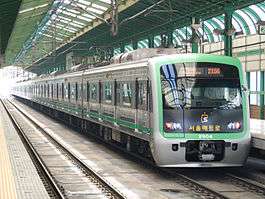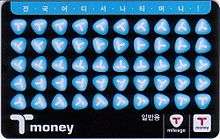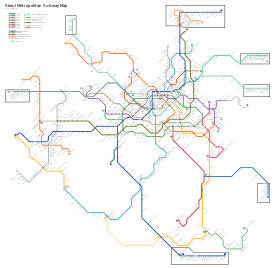Seoul Metropolitan Subway
 | |||
 | |||
| Overview | |||
|---|---|---|---|
| Native name |
수도권 전철 Sudogwon Jeoncheol | ||
| Owner | Government of South Korea, Seoul Metropolitan Government, Incheon Metropolitan City, Bucheon City, Uijeongbu City, Yongin City and private companies | ||
| Locale | Seoul Capital Area | ||
| Transit type | Rapid transit, Commuter rail | ||
| Number of lines | 22 | ||
| Number of stations | 707 | ||
| Annual ridership |
2.619 billion (2013, Lines 1-9)[1] 1.027 billion (2012, Korail)[2] | ||
| Operation | |||
| Began operation | 15 August 1974 | ||
| Operator(s) | Seoul Metro, Korail, Incheon Transit Corporation, and private rapid transit operators | ||
| Technical | |||
| System length |
331.5 km (206.0 mi) (Seoul Metro / Line 9 only)[3] 1,131 km (703 mi)[4] (all lines) | ||
| Track gauge | 1,435 mm (4 ft 8 1⁄2 in) standard gauge | ||
| |||
| Seoul Metropolitan Subway | |
| Hangul | 수도권 전철 |
|---|---|
| Hanja | 首都圈 電鐵 |
| Revised Romanization | Sudogwon Jeoncheol |
| McCune–Reischauer | Sudokwŏn Chŏnch'ŏl |
The Seoul Metropolitan Subway is a metropolitan railway system consisting of 22 rapid transit, light metro, commuter rail and people mover lines located in northwest South Korea. The system serves most of the Seoul Metropolitan Area including the Incheon metropolis and satellite cities in Gyeonggi province. Some regional lines in the network stretch out to rural areas in northern Chungnam province and western Gangwon province that lie over 100 km away from the capital as well as Suwon.[5]
The network consists of numbered lines 1–9, which serve Seoul City proper and its surroundings and named regional railways that serve the greater metropolitan region and beyond.[6] Most of the system is operated by three companies – Seoul Metro, Korail (Korea National Railroad) and Metro 9.[7] However, there are several other lines stretching out to regional provinces.
Its first metro line, Line 1, started construction in 1971 and opened in 1974, with through-operation to Korail suburban railways. Today, the network is one of the largest and most efficient urban railway systems in the world, with 331.5 km (206.0 mi) of track on lines 1–9 alone; wireless and internet service on all trains; and platform screen doors at the majority of stations. It also has real-time train information at every station.
Overview
The first line of the Seoul Subway network started construction in 1971 with economic and technical assistance from Japan.[8] The first section of subway was built using the cheaper cut and cover construction method. Line 1 opened in 1974 with through services joining surrounding Korail suburban railway lines similar to the Tokyo subway.[9] Today, many of the Seoul Metropolitan Subway's lines are operated by Korail, South Korea's national passenger and freight railway operator.[10] This is similar to Europe and Japan, where the national railroad often operates local mainline urban railways, such as the S-Bahns in Germany, operated by subsidiaries of Deutsche Bahn, or JR East in Japan, which operates many other urban rail systems in Japanese cities.
It has been described as the world's longest multi-operator metro system by route length.[11] The system was rated as one of the world's best subway systems by CNN,[12] and Jalopnik[13] It is notable for its cleanliness and ease of use along with advanced technology such as 4G LTE, WiFi, DMB, and WiBro accessible in all stations and trains.[14] Nearly all stations have platform screen doors installed; only Gaewha and some minor Korail-operated stations remain with open platforms.[15] By 2017, Korail will completely install screen doors in every station and platform.[16] The world's first virtual mart for smartphone users opened at Seolleung station in 2011.[12]
All directional signs in the system are written in Korean, English and Hanja. In trains there are in addition many LCD screens giving service announcements, upcoming stop names, YTN news, stock prices and animated shorts. There are also prerecorded voice announcements that give the upcoming station, any possible line transfer, and the exiting side in Korean, followed by English. At major stations, this is followed by Japanese, then Mandarin Chinese, as well.[17] Seoul Subway uses full-color LCD screens at all stations to display real-time subway arrival times,[18] which are also available on apps for smartphones.[19] Most trains have digital TV screens, and all of them have air conditioning and climate controlled seats installed that are automatically heated in the winter. In 2014, it became the world's first metro operator to use transparent displays for ads when it installed 48 transparent displays on major stations of Line 2 in Gangnam District.[18] All lines use the T-money smart payment system using RFID and NFC technology for automatic payment by T-money smart cards, smartphones, or credit cards and one can transfer to any of the other line within the system for free.[Note 1]
Trains on numbered lines generally run on the right-hand track, while trains on the named lines (e.g. Shinbundang Line, Bundang Line, and AREX) run on the left-hand track. The exceptions are the trains on Line 1, as well as those on Line 4 south of Namtaeryeong station. These lines run on the left-hand track because these rail lines are operated by Korail, South Korea's national railway operator.[20]
Lines and branches
The system is organised such that numbered lines, with some exceptions, are considered as urban rapid transit lines located within the Seoul National Capital Area (SNCA), whereas wide-area commuter lines operated by Korail provide a metro-like commuter rail service that usually extends far beyond the boundaries of the SNCA, rather similar to the RER in Paris. The AREX is an airport rail link that links Incheon International Airport and Gimpo Airport to central Seoul, and offers both express service directly to Incheon International Airport and all-stop commuter service for people living along the vicinity of the line. While operating hours may vary depending on the line in question, the Seoul Metropolitan Subway generally operates from 5.30 am until 1 am on weekdays, and from 5.30 am until midnight on weekends.
History
Line 1, from Seongbuk station to Incheon station and Suwon station, opened on 15 August 1974. On 9 December 1978, the Yongsan-Cheongnyangni line (now part of the Jungang Line) was added to Line 1. Line 2 opened on 10 October 1980. In 1985, the fare system changed from charging by distance to zone and the Edmondson railway ticket changed to a magnetic paper ticket. Line 4 opened on 20 April 1985, and Line 3 on 12 July. On 1 April 1994, the Indeogwon-Namtaeryeong extension of Line 4 opened. The Bundang Line, from Suseo station to Ori station, opened on 1 September. On 15 November 1995, Line 5 opened. The Jichuk-Daehwa extension of Line 3 opened on 30 January 1996. On 20 March, the Kkachisan-Sindorim extension of Line 2 opened. Line 7 opened on 11 October, and Line 8 on 23 November. On 6 October 1999, Incheon Subway Line 1 opened.
Seoul Subway Line 6 opened on 7 August 2000. In 2004 the fare system reverted to charging by distance, and free bus transfers were introduced. The Byeongjeom-Cheonan extension of Line 1 opened on 20 January 2005. On 16 December, the Jungang Line from Yongsan station to Deokso station opened. The Uijeongbu-Soyosan extension of Line 1 opened and shuttle service from Yongsan station to Gwangmyeong station began (with the route now shortened from Yeongdeungpo to Gwangmyeong) on 15 December 2006. On 23 March 2007, AREX opened. The Deokso-Paldang extension of the Jungang Line opened on 27 December. On 15 December 2008, the Cheonan-Sinchang extension of Line 1 opened. The magnetic paper ticket changed to an RFID-based card on 1 May 2009. On 1 July the Gyeongui Line from Seoul station to Munsan station opened, and on 24 July Line 9 from Gaehwa station to Sinnonhyeon station opened.
The Byeongjeom-Seodongtan extension of Line 1 opened on 26 February 2010, and the Gyeongchun Line opened on 21 December. On 28 October 2011, the Shinbundang Line from Gangnam station to Jeongja station opened. The Suin Line, from Oido Station to Songdo Station, opened on 30 June 2012. The U Line opened on 1 July, the Onsu-Bupyeong-gu Office extension of Line 7 on 27 October and the Gongdeok-Gajwa extension of the Gyeongui Line on 15 December. On 26 April 2013 EverLine opened, and the Gyeongui·Jungang Line opened on 27 December 2014. The Sinnonhyeon-Sports Complex extension of Line 9 opened on 28 March 2015. On 30 January 2016 the Jeongja-Gwanggyo extension of the Shinbundang Line opened, followed by the Songdo-Incheon extension of the Suin Line on 27 February. Incheon Subway Line 2 opened on 30 July, and the Gyeonggang Line on 24 September. The Gyeongui-Jungang Line is extended one station east to Jipyeong station on January 21, 2017, with 4 round trips to Jipyeong station. On 16 June 2018 the Seohae line opened. Magongnaru station on Line 9 became an interchange station with AREX on 29 September 2018.[30]
Rolling stock
Fares and ticketing

The Seoul Metropolitan Subway system operates on a unified transportation fare system, meaning that subways and buses in Seoul, Incheon and Gyeonggi-do are treated as one system when it comes to fares. For example, a subway rider can transfer to any other line for free (with the exception of Shinbundang Line, EverLine and U Line, which add flat extra charges, amounting to 900, 200 and 300 won respectively). One can also transfer to any city buses for free, regardless of whether it is from Seoul, Incheon or Gyeonggi-do. In the case of Shinbundang Line, if one crosses Jeongja Station, 300 won is charged on top of the 900 won extra charge, although a cashback is offered to frequent riders between Pangyo Station and Dongcheon/Suji-gu Office Station.[26]
Fare payments in Seoul are mainly handled by T-money and Cash Bee, which can also be used on buses, convenience stores and many other popular retail places. Riders must touch in a phone, card or other metro card and enabled device at the entry gates. Popular methods of payments are using NFC-enabled Android smartphones (topped up or billed to the owner's credit/debit card via the T-money app) or credit or check (debit) cards with built-in RFID technology issued by the bank or card company.
The current single-use ticket is a credit card-sized plastic card with RFID technology, which can be obtained from automated machines in every subway station. A 500 won deposit fee is included in the price, and is refunded when the ticket is returned at any station. Multiple use cards are sold in convenience stores and the functionality is included in many credit/debit cards.
Fares (except for single-use tickets) are currently 1,250 won for a trip up to 10 km, with 100 won added for each subsequent 5 km.[31] Once 50 km has been passed, 100 won will be added every 8 km. Single-use ticket users must pay RFID deposit 500 won plus 100 won surcharge to fare.
Half-priced children's tickets are available. The city government also uses Seoul Citypass as a transportation card. Senior citizens and disabled people qualify for free transit and can get a free ticket or enter and exit using side gates rather than turnstiles.
Current construction
Opening 2018
- Line 9 is being extended eastward to Veterans Hospital station by December 2018, offering a transfer to Line 8 at Seokchon station and Line 5 at Olympic Park station.[32]
Opening 2019
- Line 1 will be extended north from Soyosan station with five stations to Yeoncheon station. The existing line is being upgraded and double-tracked for frequent commuter services. Construction will complete in 2019.[33]
- Line 5 will be extended east by July 2019 from Sangil-dong station with three stations to serve Gangil-dong and Hanam (Misa New City, Pungsan development area).
- Gimpo Goldline is scheduled to open in July 2019, stretching 23.61 km over 9 stations, terminating at Gimpo International Airport station with transfers to Line 5, 9 and AREX.[34]
- The Suin Line will open Phase 3 by the end of 2019, which is an extension from Suwon station to Hanyang University at Ansan station via northern Hwaseong, where it connects with the Bundang Line as a single line.[35]
- Suin Line's Hagik Station between Songdo station and Inha University station will open after 2019 once the redevelopment of the area surrounding it is completed, which will feature new cultural, commercial and medical facilities along with new residential areas.[36]
Opening 2020
- Line 5 will be extended east by March 2020 from Pungsan to Hanam city hall and Geomdan Mountain.
- Line 7 will be extended west from Bupyeong-gu Office station to Seongnam station, offering a transfer to Incheon Subway Line 2 in June 2020.[37]
- Incheon Subway Line 1 will be extended west by 2020 from International Business District to Songdo Landmark City.
Opening 2021
- Daegok-Sosa Line will open in June 2021, connecting Daegok station of Line 3 and Gyeongui-Jungang Line to Sosa station of Line 1, where it will connect with the Seohae Line as a single line.[38] It will offer a transfer to Line 5, 9 and AREX at Gimpo International Airport station.
- Line 4 will be extended from Danggogae station to Jinjeop station.
Opening 2022
- Line 8 is being extended 6 stations northwards to Byeollae station of the Gyeongchun Line, with a transfer to Guri station of Gyeongui-Jungang Line along the way by 2022.[39]
- Shinbundang Line will be extended from Gangnam station to Sinsa station on Seoul Subway Line 3. Further extension to Yongsan station is also in the planning stages.
- Sillim Line in southwestern Seoul is scheduled to open in early half of 2022. The 11-station underground LRT line, which will provide transfers to Lines 1, 2, 7, and 9 before terminating in the south at Seoul National University.
See also
Notes
- ↑ With the exception of AREX on Yeongjong Island (extra charge applied depending on distance) and Shinbundang Line (extra flat charge of 700KRW). EverLine and U Line will allow free transfers from 2014.
References
- ↑ "Subway Passenger Transportation". City of Seoul. Retrieved 14 July 2014. (You can select English from the language dropdown that reads "한국어")
- ↑ http://news.korail.com/main/php/search_view_korail.php?idx=30712 Korail
- 1 2 3 4 5 6 7 8 9 10 지하철건설현황 [Status of Subway Construction] (in Korean). Seoul City Government. Retrieved 22 February 2014.
- ↑ Beijing's Incredible Subway Expansion In One GIF. The World Post. 29 December 2014. Retrieved 31 January 2015.
- ↑ 2012 Korail Statistics See p.400 for Seoul Metropolitan Subway (수도권 전철). Archived 27 February 2014 at the Wayback Machine.
- ↑ Ministry of Land, Transport and Maritime Affairs of South Korea: Definition of Urban Rail and Wide-area Rail Archived 25 April 2012 at the Wayback Machine.
- ↑ "Seoul Metropolitan Subway". railway-technology.com. Retrieved 2014-02-26.
- ↑ "서울 지하철 1호선" (in Korean). Seoul Metropolitan Government. Retrieved 2015-08-25.
- ↑ "Seoul's first subway line opened in 1974". Korea Times. 2011-02-13. Retrieved 2014-07-25.
- ↑ "Introducing Korail". Korail. Retrieved 2014-02-23.
- ↑ "The world's longest metro and subway systems". Railway-technology.com. Retrieved 20 February 2014.
- 1 2 "What are the world's best metro systems?". CNN. 9 January 2013. Retrieved 29 July 2014.
- ↑ Raphael Orlove. "The Best Subway Systems In The World". Jalopnik.
- ↑ "Underground world: Seoul's 'super highway' v London's 'rude tube'". BBC News. 3 April 2013. Retrieved 12 July 2013.
- ↑ Screen doors installed in the Seoul Metropolitan Subway. Koreatimes.co.kr (5 May 2009). Retrieved on 12 July 2013.
- ↑ "대중교통 커뮤니티 - SBM (철도, 버스 이용자들의 공간) : 네이버 카페". cafe.naver.com. Retrieved 27 March 2018.
- ↑ "10 Reasons Why the Seoul Subway System is the Best". Seoulistic. Retrieved 21 April 2015.
- 1 2 "낙후한 지하철 1~4호선, 첨단 디스플레이 기술로 새단장 나선다" [1-4 outdated subway line, state-of-the-art display technology sets out renovation]. etnews (in Korean). 15 March 2015. Retrieved 21 April 2015.
- ↑ Malang Studio Co. Ltd,. "Subway Korea - Android Apps on Google Play". google.com.
- ↑ 문화일보 [Munhwailbo] (16 May 2006). "<오후여담>좌측통행" [<Afternoon digression> left side of the road]. Naver (in Korean). Naver Corp. Retrieved 21 April 2015.
- 1 2 3 4 5 "Metro Lines & Trains in Operation". Korail. Retrieved 2014-07-25.
- ↑ "Southern portion of inter-Korean railway to reopen". Hankyoreh. 2014-12-25. Retrieved 2015-08-25.
- ↑ "Final Bundang Line Extension Opens". Kojects. 2013-11-30. Retrieved 2014-08-26.
- ↑ "우이신설도시철도에 오신결 환영합니다". www.ui-line.com. Retrieved 27 March 2018.
- ↑ "무인운전 시스템의 장점" (in Korean). Shinbundang Line & NeoTrans. Retrieved 2014-07-25.
- 1 2 "경기철도주식회사 - 신분당선". shinbundang2.co.kr. Retrieved 27 March 2018.
- ↑ "General information". Incheon Transit Corporation. Retrieved 2014-07-25.
- ↑ "노선안내" (in Korean). Yongin Rapid Transit Corporation. Archived from the original on 10 August 2014. Retrieved 25 July 2014.
- ↑ "사업개요" (in Korean). Uijeongbu LRT Corporation. Archived from the original on 2 November 2014. Retrieved 25 July 2014.
- ↑ "내년 지하철 9호선 마곡나루역 급행역사로 전환". 이데일리. 22 March 2017. Retrieved 27 March 2018.
- ↑ "9호선/수도권 전철 읍데이트들 - Misc Subway Updates" (Blog). Rick&Nyo. 19 April 2012. Retrieved 19 April 2012.
- ↑ "tbs". www.tbs.seoul.kr. Retrieved 27 March 2018.
- ↑ "固贰枚档DB". wo.to.
- ↑ 김포도시철도사업 (in Korean). Gimpo City. Retrieved 5 September 2014.
- ↑ "수인선 전구간 개통 계획보다 1년 늦어진다". ajunews.com. Retrieved 27 March 2018.
- ↑ ""25분 거리를 10분만에… 지역경제도 살아났으면"… 27일 완전 재개통 앞둔 수인선 시범 운행". news.kmib.co.kr. Retrieved 27 March 2018.
- ↑ "지하철 7호선 인천 연장 2년 지연...2020년 개통". KBS 뉴스.
- ↑ "김영선 "대곡-소사 복선전철 사업 예산확보 힘쓸 터"". www.newsprime.co.kr. Retrieved 27 March 2018.
- ↑ 중부일보. "지하철 8호선 구리 연장 별내선 건설 오늘 첫 삽…2022년 개통". joongboo.com. Retrieved 27 March 2018.
External links
| Wikimedia Commons has media related to: |
- Official websites by company
- Seoul city government
- The Seoul Underground Subway: Official Seoul Tourism
- English-language WMV video describing Seoul Subway history, current construction and future projects
